check engine light LEXUS RCF 2019 User Guide
[x] Cancel search | Manufacturer: LEXUS, Model Year: 2019, Model line: RCF, Model: LEXUS RCF 2019Pages: 636, PDF Size: 12.48 MB
Page 187 of 636

1873-5. Opening, closing the windows and moon roof
3
Operation of each component
RC F_U ■
The moon roof can be operated when
The engine switch is in IGNITION ON mode. ■
Operating the moon roof after turning the engine off
The moon roof can be operated for approximat ely 45 seconds after the engine switch is
turned to ACCESSORY mode or turned off. It cannot, however, be operated once either
door is opened. ■
Jam protection function
If an object is detected between the moon r oof and the frame while the moon roof is clos-
ing or tilting down, travel is stopped and the moon roof opens slightly. ■
Sunshade
The sunshade can be opened and closed manually. Howe ver, the sunshade will open
automatically when the moon roof is opened. ■
Door lock linked moon roof operation ●
The moon roof can be opened and closed using the mechanical key.
* ( P. 519)●
The moon roof can be opened us ing the wireless remote control.
* ( P. 145)
* : These settings must be cust omized at your Lexus dealer.■
If the moon roof does not close normally
Perform the following procedure:
Stop the vehicle.
Press and hold the “CLOSE” switch.
*The moon roof will close, reopen and pause for approximately 10 seconds. Then it will
close again and stop at the completely closed position.
Check to make sure that the moon roof is completely closed and then release the
switch.
* : If the switch is released at the incorrect time, the procedure will have to be performed
again from the beginning.
If the moon roof does not fully close even after performing the above procedure cor-
rectly, have the vehicle inspected by your Lexus dealer. 1
2
3
Page 195 of 636

1954-1. Before driving
4
Driving
RC F_U WARNING
Observe the following precautions.
Failure to do so may result in death or serious injury. ■
When starting the vehicle
Always keep your foot on the brake pedal while stopped with the engine running. This
prevents the vehicle from creeping. ■
When driving the vehicle ●
Do not drive if you are unfamiliar with the location of the brake and accelerator ped-
als to avoid depressing the wrong pedal.
• Accidentally depressing the accelerator pedal instead of the brake pedal will
result in sudden acceleration that may lead to an accident.
• When backing up, you may twist your body around, leading to a difficulty in oper-
ating the pedals. Make sure to operate the pedals properly.
• Make sure to keep a correct driving po sture even when moving the vehicle only
slightly. This allows you to depress th e brake and accelerator pedals properly.
• Depress the brake pedal using your right foot. Depressing the brake pedal using
your left foot may delay re sponse in an emergency, resulting in an accident.●
Do not drive the vehicle over or stop the vehicle near flammable materials.
The exhaust system and exhaust gases can be extremely hot. These hot parts may
cause a fire if there is any flammable material nearby. ●
During normal driving, do not turn off the engine. Turning the engi ne off while driving
will not cause loss of steering or braking control, but the power assist to these systems
will be lost. This will make it more difficult to steer and brake, so you should pull over
and stop the vehicle as soon as it is safe to do so.
However, in the event of an emergency, such as if it becomes impossible to stop the
vehicle in the normal way: P. 443●
Use engine braking (downshift) to maintain a safe speed when driving down a steep
hill.
Using the brakes continuously may cause th e brakes to overheat and lose effective-
ness. ( P. 213)●
Do not adjust the positions of the steering wheel, the seat, or the inside or outside rear
view mirrors while driving.
Doing so may result in a loss of vehicle control. ●
Always check that all passengers’ arms, he ads or other parts of their body are not
outside the vehicle. ●
Do not drive in excess of the speed limit. Even if the legal speed limit permits it, do not
drive over 85 mph (140 km/h) unless your vehicle has high-speed capability tires.
Driving over 85 mph (140 km/h ) may result in tire failure , loss of control and possible
injury. Be sure to consult a tire dealer to determine whether the tires on your vehicle
are high-speed capability tires or no t before driving at such speeds.
Page 196 of 636

196 4-1. Before driving
RC F_U WARNING
Observe the following precautions.
Failure to do so may result in death or serious injury. ■
When driving on slippery road surfaces ●
Sudden braking, acceleration and steering may cause tire slippage and reduce your
ability to control the vehicle. ●
Sudden acceleration, engine braking due to shifting, or changes in engine speed
could cause the vehicle to skid. ●
After driving through a puddle , lightly depress the brake pe dal to make sure that the
brakes are functioning properly. Wet brake pads may prevent the brakes from func-
tioning properly. If the brakes on only on e side are wet and not functioning properly,
steering control may be affected. ■
When shifting the shift lever ●
Do not let the vehicle roll backward while the shift lever is in a driving position, or roll
forward while the shift lever is in R.
Doing so may cause the engine to stall or lead to poor brake and steering perfor-
mance, resulting in an accide nt or damage to the vehicle.●
Do not shift the shift lever to P while the vehicle is moving.
Doing so can damage the transmission and may result in a loss of vehicle control.●
Do not shift the shift lever to R while the vehicle is moving forward.
Doing so can damage the transmission and may result in a loss of vehicle control.●
Do not shift the shift lever to a driving posi tion while the vehicle is moving backward.
Doing so can damage the transmission and may result in a loss of vehicle control.●
Moving the shift lever to N while the vehicle is moving will disengage the engine from
the transmission. Engine braking is not available when N is selected.●
Be careful not to shift the shift lever with the accelerator pedal depressed. Shifting the
shift lever to a gear other than P or N may lead to unexpected rapid acceleration of
the vehicle that may cause an accident and result in death or serious injury. ■
If you hear a squealing or scraping noise (brake pad wear limi t indicators) (RC350/
RC300)
Have the brake pads checked and replaced by your Lexus dealer as soon as possible.
Rotor damage may result if the pads are not replaced when needed.
Front brakes on F SPORT models (RC3 50 [2WD]/RC300 [2WD] only): Moderate
levels of brake pad and disc wear allow enhanced front braking power. As a result, the
discs may wear more quickly than convention al brake discs. Therefore, when replacing
the brake pads, Lexus recommends that you al so have the thickness of the discs mea-
sured.
It is dangerous to drive the vehicle when the wear limits of the brake pads and/or those
of the brake discs are exceeded.
Page 212 of 636
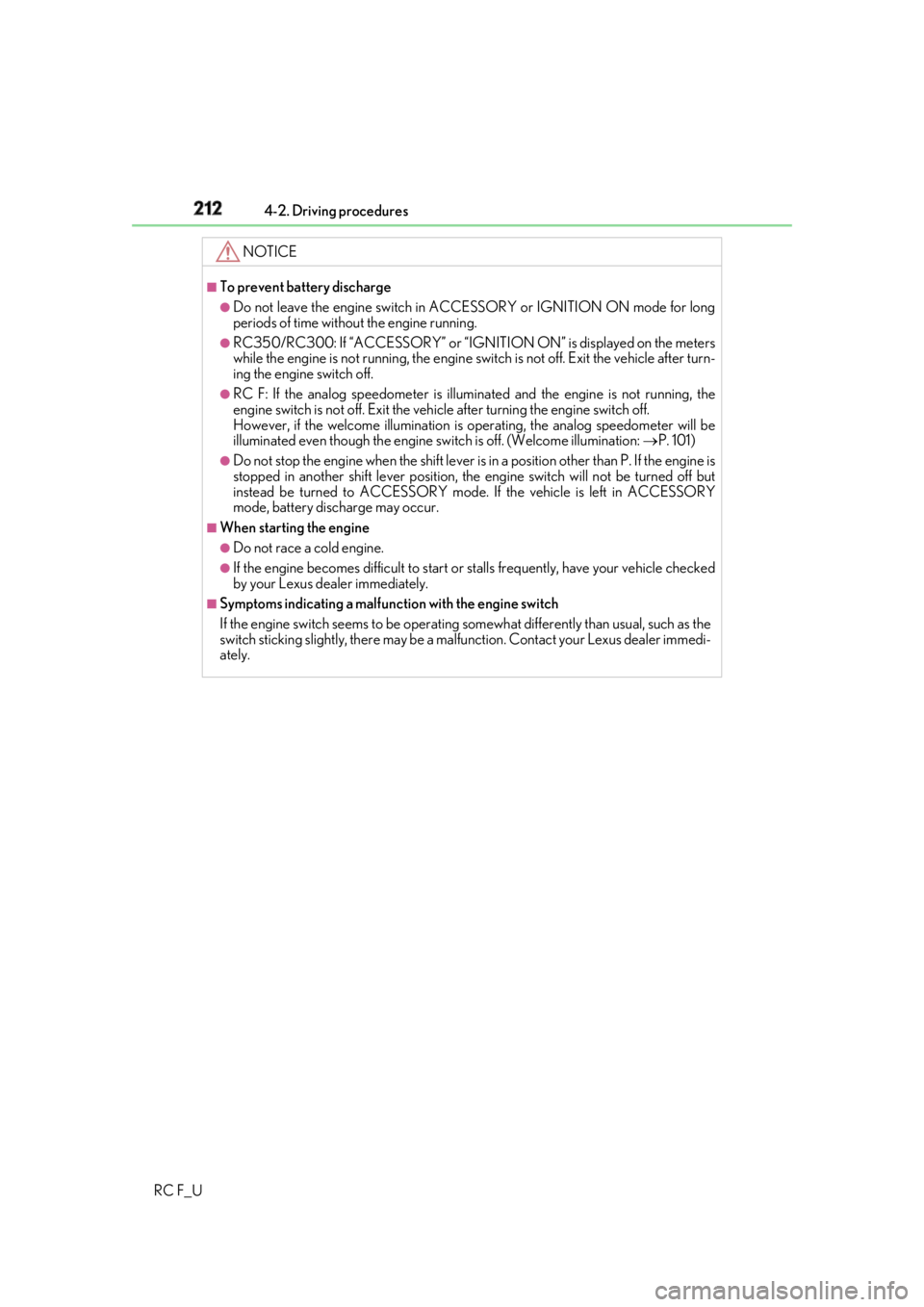
212 4-2. Driving procedures
RC F_U NOTICE ■
To prevent battery discharge ●
Do not leave the engine switch in AC CESSORY or IGNITION ON mode for long
periods of time without the engine running. ●
RC350/RC300: If “ACCESSORY” or “IGN ITION ON” is displayed on the meters
while the engine is not running, the engine switch is not off. Exit the vehicle after turn-
ing the engine switch off. ●
RC F: If the analog speedometer is illu minated and the engine is not running, the
engine switch is not off. Exit the vehicle after turning the engine switch off.
However, if the welcome illumination is operating, the analog speedometer will be
illuminated even though the engine sw itch is off. (Welcome illumination: P. 101)●
Do not stop the engine when the shift lever is in a position other than P. If the engine is
stopped in another shift lever position, the engine switch will no t be turned off but
instead be turned to ACCESSORY mode. If the vehicle is left in ACCESSORY
mode, battery discharge may occur. ■
When starting the engine ●
Do not race a cold engine. ●
If the engine becomes difficult to start or stalls frequently, have your vehicle checked
by your Lexus dealer immediately. ■
Symptoms indicating a malfun ction with the engine switch
If the engine switch seems to be operating somewhat differen tly than usual, such as the
switch sticking slightly, ther e may be a malfunction. Contact your Lexus dealer immedi-
ately.
Page 221 of 636
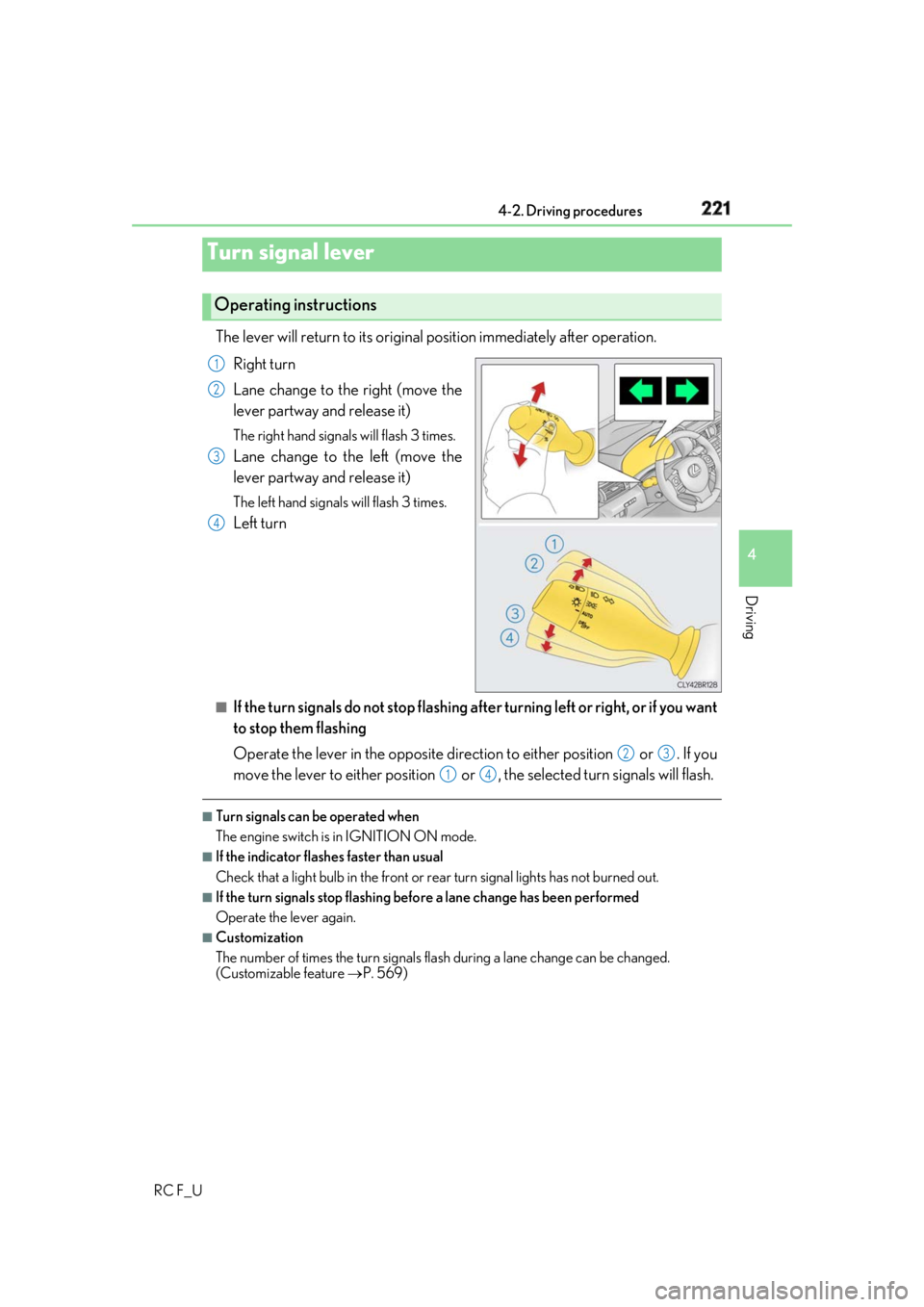
2214-2. Driving procedures
4
Driving
RC F_U The lever will return to its original position immediately after operation.
Right turn
Lane change to the right (move the
lever partway and release it) The right hand signals will flash 3 times.
Lane change to the left (move the
lever partway and release it) The left hand signals will flash 3 times.
Left turn
■
If the turn signals do not stop flashing af ter turning left or right, or if you want
to stop them flashing
Operate the lever in the opposite direct ion to either position or . If you
move the lever to either position or , the selected turn signals will flash. ■
Turn signals can be operated when
The engine switch is in IGNITION ON mode. ■
If the indicator flashes faster than usual
Check that a light bulb in the front or rear turn signal lights has not burned out.■
If the turn signals stop flashing befo re a lane change has been performed
Operate the lever again. ■
Customization
The number of times the turn signals flas h during a lane change can be changed.
(Customizable feature P. 569)Turn signal lever Operating instructions 1
2
3
4
2 3
1 4
Page 239 of 636
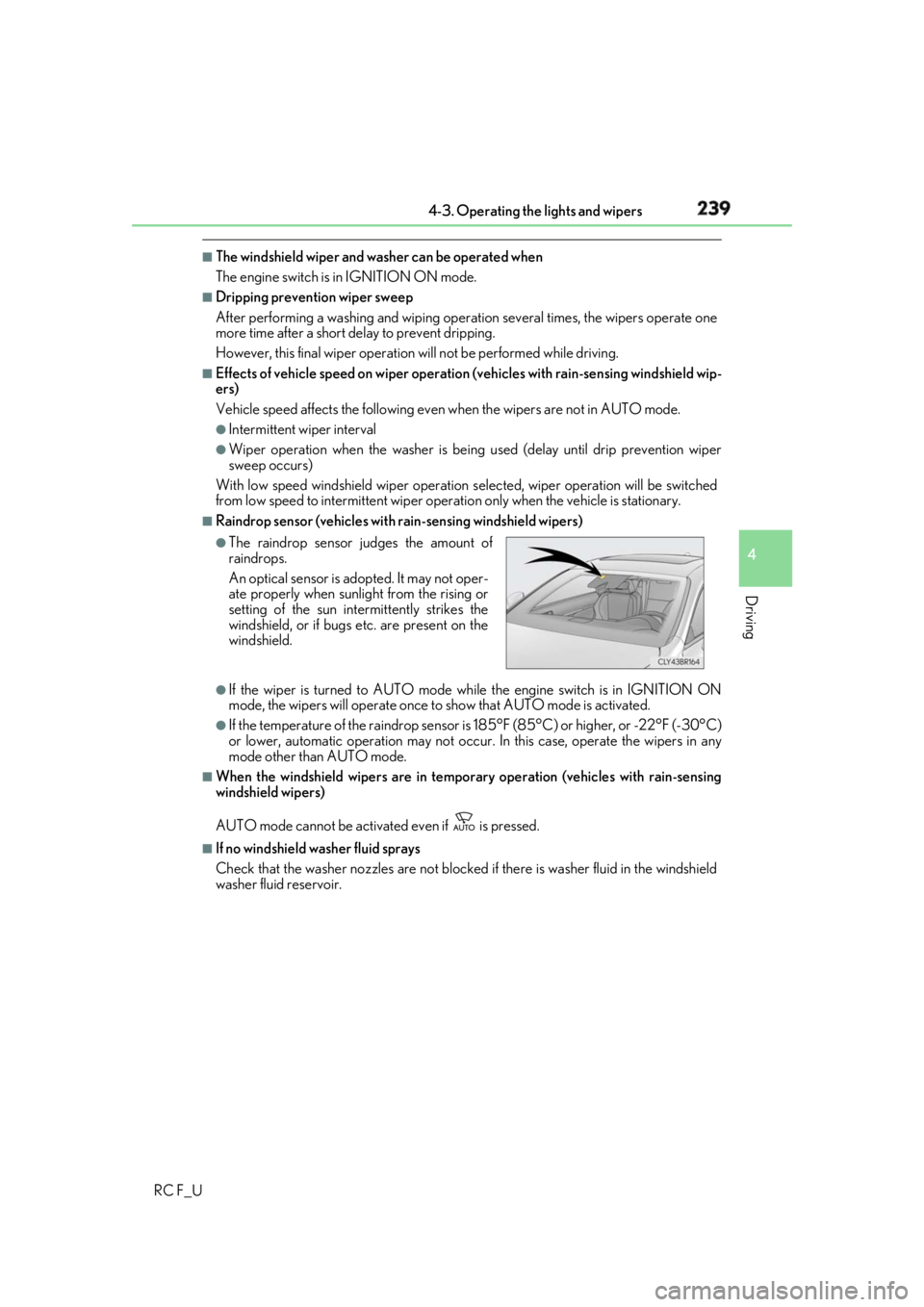
2394-3. Operating the lights and wipers
4
Driving
RC F_U ■
The windshield wiper and washer can be operated when
The engine switch is in IGNITION ON mode. ■
Dripping prevention wiper sweep
After performing a washing and wiping operation several times, the wipers operate one
more time after a short delay to prevent dripping.
However, this final wiper operation will not be performed while driving.■
Effects of vehicle speed on wiper operation (vehicles with rain-sensing windshield wip-
ers)
Vehicle speed affects the following even when the wipers are not in AUTO mode. ●
Intermittent wiper interval ●
Wiper operation when the washer is being used (delay until drip prevention wiper
sweep occurs)
With low speed windshield wi per operation selected, wipe r operation will be switched
from low speed to intermittent wiper operation only when the vehicle is stationary. ■
Raindrop sensor (vehicles with rain-sensing windshield wipers)
●
If the wiper is turned to AUTO mode wh ile the engine switch is in IGNITION ON
mode, the wipers will operate once to show that AUTO mode is activated.●
If the temperature of the rain drop sensor is 185°F (85°C) or higher, or -22°F (-30°C)
or lower, automatic operation may not occur. In this case, operate the wipers in any
mode other than AUTO mode. ■
When the windshield wipers are in tempor ary operation (vehicles with rain-sensing
windshield wipers)
AUTO mode cannot be activa ted even if is pressed.■
If no windshield washer fluid sprays
Check that the washer nozzles are not blocked if there is washer fluid in the windshield
washer fluid reservoir. ●
The raindrop sensor judges the amount of
raindrops.
An optical sensor is ad opted. It may not oper-
ate properly when sunlight from the rising or
setting of the sun inte rmittently strikes the
windshield, or if bugs etc. are present on the
windshield.
Page 375 of 636

375
Maintenance and care
6
RC F_U 6-1. Maintenance and care
Cleaning and protecting
the vehicle exterior ................ 376
Cleaning and protecting
the vehicle interior................... 381
6-2. Maintenance
Maintenance
requirements ............................384
General maintenance.............. 387
Emission inspection and
maintenance (I/M)
programs ....................................390
6-3. Do-it-yourself
maintenance
Do-it-yourself service
precautions................................. 391
Hood ............................................... 393
Positioning a floor jack ............ 394
Engine compartment ............... 397
Tires ...................................................412
Tire inflation pressure............... 420
Wheels ........................................... 423
Air conditioning filter ............... 425
Electronic key battery .............. 427
Checking and replacing
fuses .............................................. 429
Light bulbs..................................... 432
Page 415 of 636

4156-3. Do-it-yourself maintenance
RC F_U 6
Maintenance and care ■
When to replace your vehicle’s tires
Tires should be replaced if: ●
The treadwear indicators are showing on a tire. ●
You have tire damage such as cuts, splits, cracks deep enou gh to expose the fabric, and
bulges indicating internal damage ●
A tire goes flat repeatedly or cannot be properly repaired due to the size or location of
a cut or other damage
If you are not sure, consult your Lexus dealer. ■
Replacing tires and wheels
If the ID code of the tire pressure warning valve and transmitter is not registered, the tire
pressure warning system will not work proper ly. After driving for about 20 minutes, the
tire pressure warning light blinks for 1 minu te and stays on to indicate a system malfunc-
tion. ■
Tire life
Any tire over 6 years old must be checked by a qualified technician even if it has seldom
or never been used or damage is not obvious.■
Routine tire inflation pressure checks
The tire pressure warning syst em does not replace routine tire inflation pressure checks.
Make sure to check tire inflat ion pressure as part of your routine of daily vehicle checks.■
When rotating the tires
Make sure that the engine switch is off. If the tires are rotated while the engine switch is in
IGNITION ON mode, the tire position information will not be updated.
If this accidentally occurs, either turn the engine switch to off and then to IGNITION ON
mode, or initialize the system after checking th at the tire pressure is properly adjusted.■
Low profile tires
Generally, low profile tires will wear more rapidly and tire grip performance will be
reduced on snowy and/or icy roads when comp ared to standard tires. Be sure to use
snow tires or tire chains on snowy and/or icy roads and drive carefully at a speed appro-
priate for road and weather conditions.
Page 457 of 636
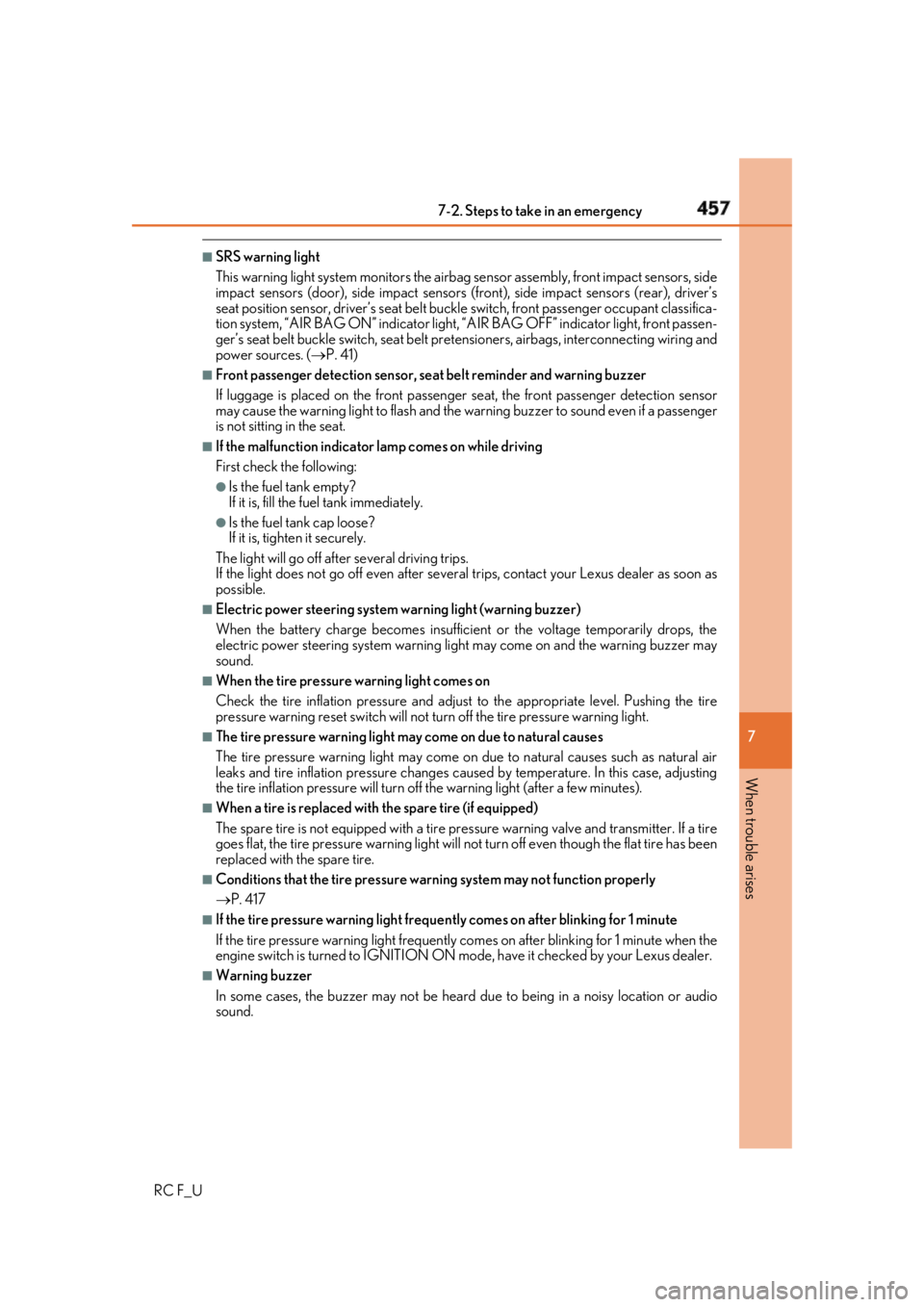
4577-2. Steps to take in an emergency
RC F_U 7
When trouble arises ■
SRS warning light
This warning light system monitors the airbag sensor assembly, front impact sensors, side
impact sensors (door), side impact sensors (front), side im pact sensors (rear), driver’s
seat position sensor, driver’s seat belt buckle switch, front passenger occupant classifica-
tion system, “AIR BAG ON” indicator light, “A IR BAG OFF” indicator light, front passen-
ger’s seat belt buckle switch, seat belt pretensioners, airbags, interconnecting wiring and
power sources. ( P. 41) ■
Front passenger detection sensor, seat belt reminder and warning buzzer
If luggage is placed on the front passenger seat, the front passenger detection sensor
may cause the warning light to flash and the warning buzzer to sound even if a passenger
is not sitting in the seat. ■
If the malfunction indicator lamp comes on while driving
First check the following: ●
Is the fuel tank empty?
If it is, fill the fu el tank immediately.●
Is the fuel tank cap loose?
If it is, tighten it securely.
The light will go off after several driving trips.
If the light does not go off even after severa l trips, contact your Lexus dealer as soon as
possible. ■
Electric power steering system warning light (warning buzzer)
When the battery charge becomes insufficien t or the voltage temporarily drops, the
electric power steering system warning li ght may come on and the warning buzzer may
sound. ■
When the tire pressure warning light comes on
Check the tire inflation pressu re and adjust to the approp riate level. Pushing the tire
pressure warning reset switch will not tu rn off the tire pressure warning light.■
The tire pressure warning light ma y come on due to natural causes
The tire pressure warning light may come on due to natural causes such as natural air
leaks and tire inflation pressure changes caus ed by temperature. In this case, adjusting
the tire inflation pressure will turn off the warning light (aft er a few minutes).■
When a tire is replaced with the spare tire (if equipped)
The spare tire is not equipped with a tire pr essure warning valve and transmitter. If a tire
goes flat, the tire pressure warning light will not turn off even though the flat tire has been
replaced with the spare tire. ■
Conditions that the tire pressure wa rning system may not function properly
P. 417 ■
If the tire pressure warning light freque ntly comes on after blinking for 1 minute
If the tire pressure warning light frequently comes on after blinking for 1 minute when the
engine switch is turned to IGNITION ON mo de, have it checked by your Lexus dealer.■
Warning buzzer
In some cases, the buzzer ma y not be heard due to being in a noisy location or audio
sound.
Page 475 of 636
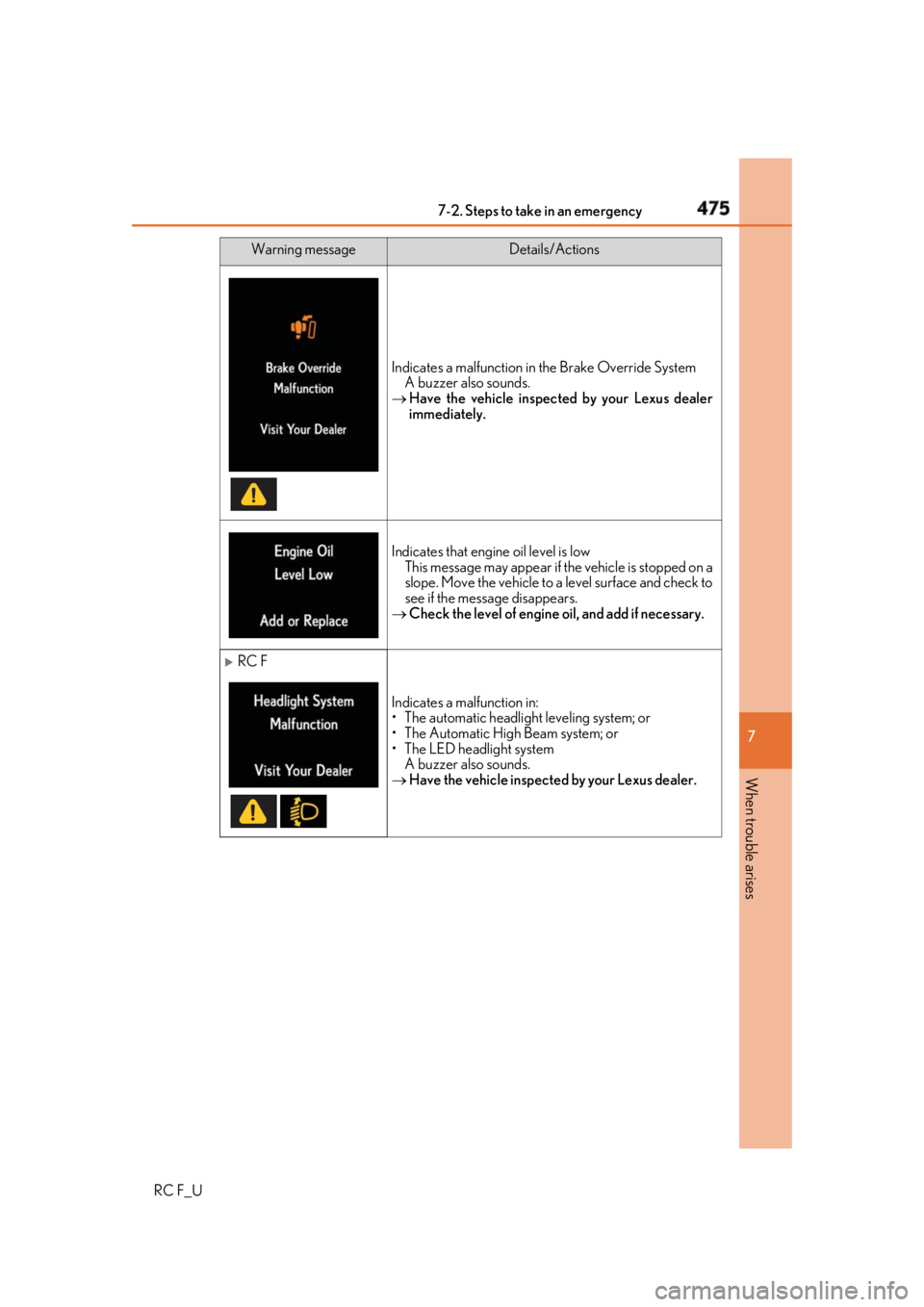
4757-2. Steps to take in an emergency
RC F_U 7
When trouble arises Indicates a malfunction in the Brake Override System
A buzzer also sounds.
Have the vehicle inspecte d by your Lexus dealer
immediately.
Indicates that engine oil level is low
This message may ap pear if the vehicle is stopped on a
slope. Move the vehicle to a level surface and check to
see if the message disappears.
Check the level of engine oil, and add if necessary.
RC F
Indicates a malfunction in:
• The automatic headlight leveling system; or
• The Automatic High Beam system; or
• The LED headlight system
A buzzer also sounds.
Have the vehicle inspected by your Lexus dealer.Warning message Details/Actions